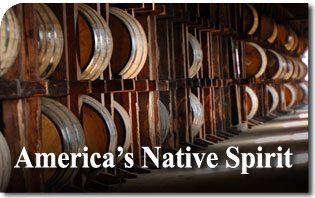 It might appear to a casual observer that the United States is not a country where one would find a healthy regionalism. Nowhere is this more apparent than in the Bluegrass State which is commonly seen merely as the home of Kentucky Fried Chicken. Those who see it this way might be surprised to learn that a centuries-old tradition of producing world-class bourbon found its origin right here in tiny Nelson County, Kentucky. This not only represents another example of an Only in America paradox but it is another refreshing example of what we can discover when we get off the beaten path.
It might appear to a casual observer that the United States is not a country where one would find a healthy regionalism. Nowhere is this more apparent than in the Bluegrass State which is commonly seen merely as the home of Kentucky Fried Chicken. Those who see it this way might be surprised to learn that a centuries-old tradition of producing world-class bourbon found its origin right here in tiny Nelson County, Kentucky. This not only represents another example of an Only in America paradox but it is another refreshing example of what we can discover when we get off the beaten path.
It was a particularly picturesque morning as I drove down the Bluegrass Parkway across rolling hills towards Bardstown, Kentucky. The sun peeped below a low lying mist and cast a marvelous bronze hue across the frost-covered landscape. This is the heart of Kentucky’s Bourbon Trail and the dream-like color of the countryside that day seemed identical to the wonderful liquid which has put it on the world map. This idyllic morning, I would later find out, revealed a profound symbolism; that which makes Kentucky bourbon so extraordinary has as much to do with the soil from which it is born as the people who harness its potential for excellence. This is what gives it such a refreshing regional character.
“A region,” according to John Horvat in his book Return to Order, “is formed by the intimate relationship between a people and a place.” He goes on to point out how such a place has its “own vegetation, lay of the land, natural wonders, hinterland, and mysteries.” 1
This is what one can see in this area of the Bluegrass State, particularly Bourbon County, which sits atop a massive, six-county-wide limestone shelf. This calcium-rich water filters out the unwanted iron that provides ideal water for bourbon. Curiously enough, it is the same bone-strengthening water that is a contributing factor in producing million dollar racehorses and explains why Kentucky’s numerous distilleries are intertwined with finely manicured thoroughbred farms.
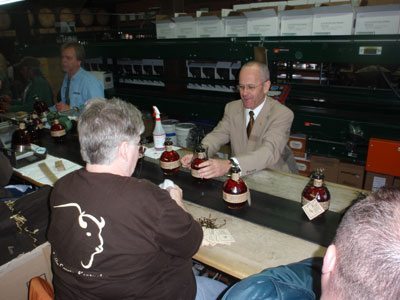
The other element that must not be overlooked are the white oak trees native to this region that are used to make barrels for aging bourbon. During the hot, humid Kentucky summers, the bourbon expands into the walls of the barrel. In the cold winter it retracts, taking with it a variety of flavors, anything from vanilla, caramel to fruity or citrus notes and… the marvelous amber color.
Lastly, it’s Kentucky rich soil that produces an abundance of another essential ingredient, corn. For it to be called Bourbon, there has to be at least 51% corn in the mash.
“Sometimes it seems that there are places that Providence has blessed with harmonic features,” Mr. Horvat continues, “as if awaiting inhabitants.” 2 Everything necessary to make excellent bourbon was put in place for just such people and their arrival would occur in an unexpected way.
The Origins of “Old Bourbon”
It all began with the Whiskey Rebellion of 1791 when George Washington imposed an excise tax on the domestic manufacture of all “spirits.” Disgruntled European immigrants – primarily Scottish, Irish and Germans – were furious over what they considered an unjust levy on a product they brought from the Old World and decided to pack up and head south to the fledgling Commonwealth of Kentucky. They eventually settled in Bourbon County named after the French royal family. This county was eventually carved into many smaller ones, but many people continued to call the region Old Bourbon. Located within its boundaries was the principal Ohio River port from which whiskey and other products were shipped south. 3
They recommenced making their fine whiskey but when they shipped it down the Ohio and Mississippi Rivers to New Orleans in oak barrels, a curious thing happened. The long trip aged the whiskey, thus enhancing its taste profile, while the oak wood gave the drink its distinct mellow flavor and trademark color. The recipients of this unique spirit enjoyed it very much but were curious as to what it was called. Seeing “Old Bourbon” stenciled on the barrels – to indicate their port of origin – they began calling it bourbon. 4
This was the beginning of a liquor that would go on to earn the name of “America’s Native Spirit.” 5 Since then, generations of Kentuckians have continued the heritage and time-honored tradition of making fine bourbon, unchanged from the process used by their ancestors. It has become an international symbol of Kentucky craftsmanship and tradition which has attracted nearly two million visitors from around the world in the last five years alone. 6
Bourbon “Nobility”
One name that is indisputably linked to the industry is Jacob Beam. After immigrating to America from Germany in the eighteenth century, he started his first distillery in 1788 with a special strain of yeast, which he carefully guarded from the hot summers by placing it in a jug then depositing it in a nearby creek to keep cool. He would go on to teach his son everything he knew about making bourbon, and they in turn passed on the knowledge to their sons and grandsons.
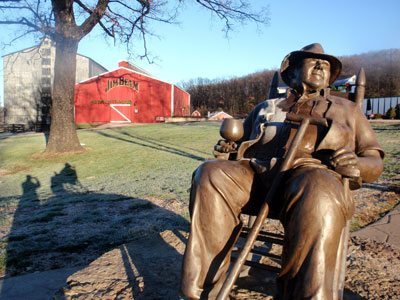
A youthful and bubbly Erica Boone was my tour guide the day I visited this historic distillery. She is a descendant of Daniel Boone but her face glowed with pride when she named another of her ancestors. “I am an eight generation Jacob Beam,” she said, alluding to the patriarch of the family.
She went on to explain how Beam, like most distilleries, was shut down in 1919 during Prohibition and was forced to liquidate its inventory. Jim Beam, great grandson of the founder, figured this period would not last long so he carefully studied aquifer maps for areas most rich in limestone and eventually found a choice piece of land in Clermont, Kentucky. His wisdom paid off.
Prohibition was eventually repealed in 1933, and they started up where they had left off. The distillery has grown quite a bit since then. They now have nineteen 35,000-gallon fermenters and have produced over 12 million barrels of bourbon to date. Their White Label Jim Beam is the most recognized bourbon in the world which might explain the enthusiasm of a Scotsman who recently toured the plant. While his countrymen might be known for producing great Scotch, he was forced to admit that by coming to Jim Beam he had arrived at “the Mecca.”
The dynasty of Beam distillers and their artistry have shaped the industry so much they could very well be considered the American aristocracy in the bourbon industry. I found this out firsthand at the end of my tour when Erica made a passing reference to their current Master Distiller, whose last name was Noe.
The Beam dynasty begun by Jacob, Miss Boone explained, was later transferred to the Noe line when T. Jeremiah Beam – great, great grandson of Jacob – did not have children. His sister Margaret married Frederick Booker Noe and their son Frederick Booker Noe II would continue the family tradition begun centuries before. She perhaps noticed my disappointment at what appeared to be a break from tradition and candidly explained: “It’s just like a king who produces no male offspring and passes on his crown to the princess.”
The original Beam name, however, can still be found throughout the bourbon world. The master distiller at Heaven Hill, Kentucky’s largest distillery, is cousin Parker Beam who has been sharing his knowledge for over 53 years. He is joined by his son, Craig Beam, who will no doubt continue enriching the bourbon family tree.
“I love what I do,” Erica admitted. “I am not just an employee; I am a member of the family…” Her words trailed off as she begged pardon for “getting teary eyed.” When she regained her composure I asked “Why the tears?”
“It’s the heritage,” she responded. “You have no idea what it means to be able to trace your roots back 200 years. It gives such a sense of self awareness.”
Hotbeds of Distilling Prowess
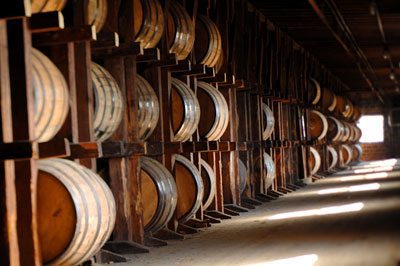
This same sense of intense pride shines through in every distillery you find in the Bluegrass State. Employees at each one, even those not directly related to patriarchal figures, pride themselves in simply being a part of this rich tradition.
It is for this reason that one should not visit the area without a stop at Buffalo Trace in Frankfort. They are the only distillery in Kentucky that continued to operate un-interrupted during Prohibition because they were allowed to sell their product for medicinal purposes. No longer being limited to curing the body, they are now allowed to delight the soul of bourbon connoisseurs the world over. Their finest product, George T. Stagg, just won the International Spirit of the World Award last year by knocking off the yearly favored Highland Park 18 Scotch Whiskey from the Northern Highlands.
“Spirits are continually getting better and more sophisticated each year,” says noted spirits reviewer Paul Pacult. “It’s no surprise to us that three of the top five spirits in the world hail from Kentucky, which right now is one of the hotbeds of distilling prowess.” 7
“What We Could Enjoy Every Day.”
Freddie Johnson is likely one of the more knowledgeable persons in the state on bourbon and was my tour guide for the day. He spoke, with about as much pride as Miss Boone, that he is a third generation employee for the distillery and described the charming way he ended up there. He was in the middle of a successful career as a network engineer and at one point enjoyed security clearance for tracking Air Force One. He would eventually put all this aside to fulfill a twofold request of his father Jimmy.
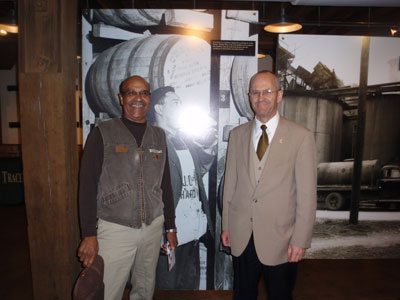
Employees at these distilleries, even those not directly related to patriarchal figures, pride themselves in simply being a part of this rich tradition.
“He made me promise to allow him to die in his own bed,” he explained, “rather than a nursing home.” The other request had to do with keeping the family tradition. “He wanted me to work at Buffalo Trace while he was still alive.”
Tears rolled down his cheeks as he described the day his father called with the news that both he and Freddie’s brother had come down with terminal cancer and were nearing the end of their lives. Freddie did not hesitate to fulfill both of his father’s wishes. He took an early retirement, returned to Kentucky and described how he and his father took one last walk through the distillery’s main warehouse on his father’s 92nd birthday. “He told me things about the distillery that his father had taught him,” Freddie explained.
He then recounted the most memorable conversation he ever had with his father while sipping from an old bottle of bourbon that had been signed by the current and previous Buffalo Trace Master Distillers. 8 Freddie opened it to celebrate his father’s 94th birthday. After pouring a shot for his father, his brother and himself, Freddie put the cork back in the bottle.
“What on earth are you doing son?” his father sternly asked. “There will always be old bottles of bourbon. They are being made every day, but friends and family will not always be around and that is what bourbon is made for. Don’t ever do that again.”
The message was clear, he said, bourbon is meant to be enjoyed with the moment. It was the first time that his father, brother and he had really talked since they were very young. Three hours later Freddie helped his ailing, but now delighted, father into bed.
“This is the best birthday I ever had.” Eleven months later his father and brother were both dead but the memory of that day and the lesson learned lives on.
“There is a saying,” Freddie concluded, “that says, ‘if time was not a factor in our lives this is what we could enjoy every day.’”
Made in America
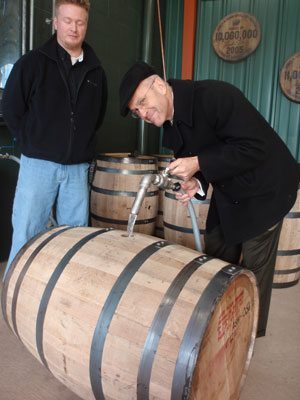
at the Jim Beam distillery.
Before leaving the state, I stopped at Wild Turkey distillery, took the tour and sampled some of their excellent product. In the gift shop I had a chat with Scott and Beth Ryan who had travelled from Columbus, Ohio. Mr. Ryan explained how they had decided to travel Kentucky’s bourbon trail because he had seen an episode of John Ratzenberger’s Made in America which highlighted the bourbon making process at Maker’s Mark.
After having seen it with her own eyes, Beth described how she was attracted by the regionalism expressed in the entire bourbon trail. She quickly added how she was fed up with the standardization in our country.
The most meaningful part of the tour was the hands-on approach they found at Maker’s Mark. “Dipping your finger in a massive pot of whiskey to taste the product and then dipping your own bottle into the red wax to make your very own Maker’s Mark trademark seal.”
“I just like the uniqueness and pride of the Kentucky bourbon industry,” she said.
As I left the State of Kentucky I was happy for traveling the Bourbon Trail and I agree with the Ryans. This detour allowed me to discover yet one more example of American regionalism. However, I was only able to see it because I got off the beaten path.
Footnotes
- John Horvat II, Return to Order, York Press, p. 205
- Ibid
- Charles Cowdery, Bourbon, Straight: The Uncut and Unfiltered Story of American Whiskey, p. 25
- John Horvat II, Return to Order, York Press, p. 205
- This name was granted by a Congressional resolution in 1964.
- http://kybourbontrail.com/index.php/history/)
- http://www.prnewswire.com/news-releases/george-t-stagg-named-top-spirit-in-the-world-for-second-year-in-a-row-155340915.html
- This was special because Buffalo Trace is the only distillery that has three living Master Distillers. The oldest, Elmer T. Lee, is 93 years old and is one of only three living Master Distillers that have a bourbon named after them.

